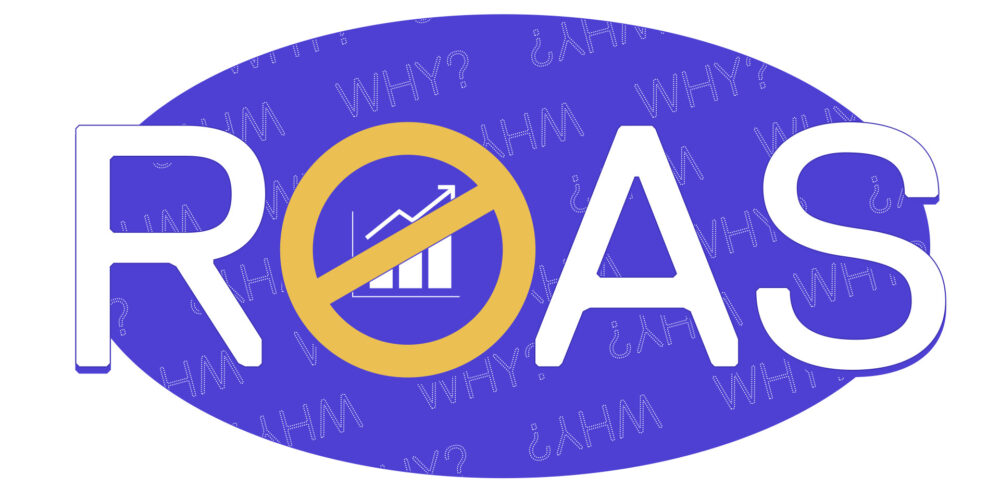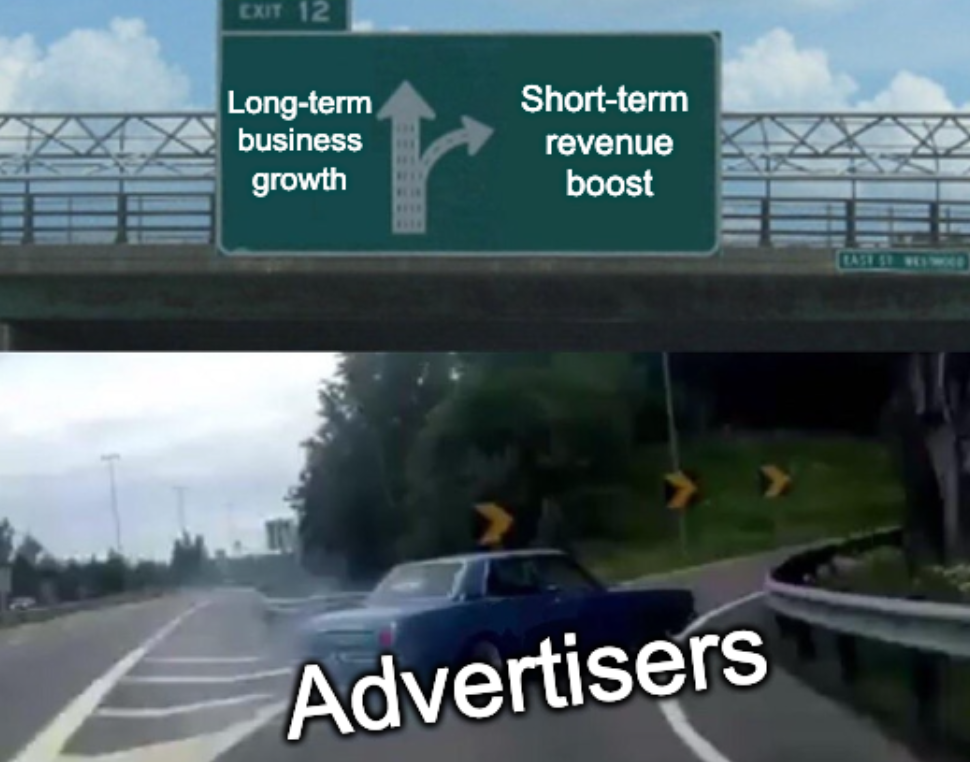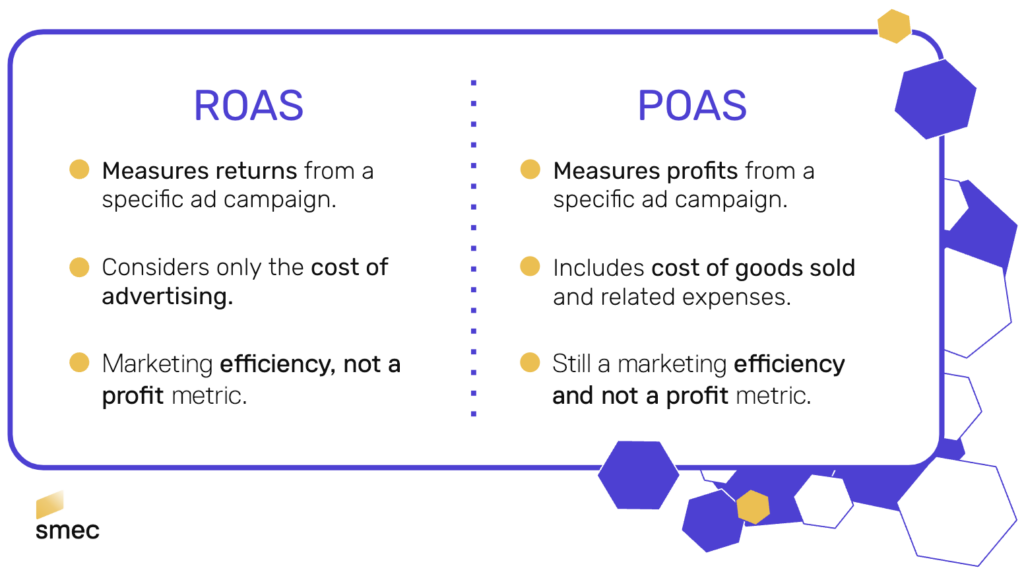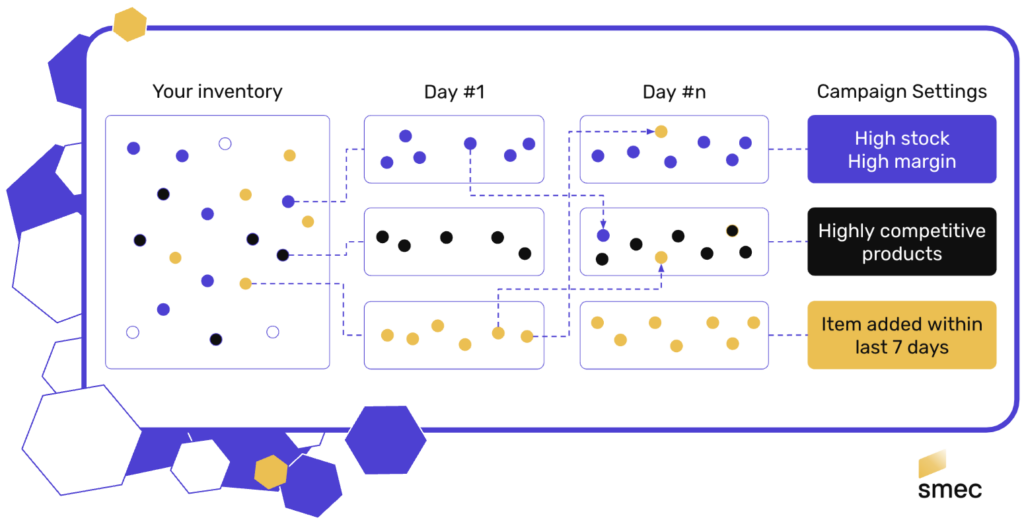Subscribe to join thousands of other ecommerce experts

Here is a harsh truth: Too many advertisers are so addicted to ROAS that they completely ignore tactics that will actually make their business more profitable and healthy.
If that sounds all too familiar to you, we suggest kicking this bad habit now and starting to be more strategic.
So let’s go cold turkey –
Table of Contents
ROAS: Just one piece of the puzzle
Return on Ad Spend (ROAS) measures the efficiency of your advertising spend, showing the revenue generated for every dollar spent on ads. It’s a popular metric because it’s easy to understand and track.
Additionally, highly automated campaign types – like Performance Max – use ROAS as the only lever to optimize ads towards performance.
So understandably, many retailers rely heavily on ROAS simply because it is one of the few steering options available to them out-of-the-box in their advertising ventures.
Now, we don’t want to bad-mouth ROAS – even though we are admittedly pretty good at it. 😉
ROAS is absolutely essential to measure the efficiency of your ad spend and to understand how well your ads are driving revenue. But as is often the case, there can be too much of a good thing.
To us, ROAS is a bit of an ‘advertising ice cream’. Hey, we love ourselves some ice cream, but we don’t want to overeat on it, do we?
Simply put, over-optimizing ads towards high ROAS will definitely give you a misleading perspective on your overall business health.

The ROAS trap: When efficiency misleads
Over-optimizing for ROAS can lead to several pitfalls that undermine long-term profitability and strategic growth:
Limiting revenue growth:
An excessively high ROAS might indicate under-investment in growth opportunities. Sometimes, lowering your ROAS can lead to greater revenue by capturing a larger market share.
Misleading profitability:
A high ROAS might mask low-profit margins. For starters: ROAS doesn’t consider additional costs – like shipping/fulfullment, returns, digital taxes, coupons etc.
Or in other words: Achieving an excellent ROAS by promoting low-margin products can result in impressive revenue but poor overall profitability.
Ignoring strategic goals:
Solely focusing on ROAS can distract from broader strategic objectives such as giving your very own first-party products more visibility in the ads game. Or acquiring new customers yet unfamiliar with your brand.
A little thought experiment:
Say you are selling consumer electronics, including high-margin laptops and low-margin accessories.
- Pushing the wrong products:
Your advertising focuses on selling phone chargers and cables, which have a low cost and sell in high volume. This results in a high ROAS because the revenue generated from these accessories is significant compared to the ad spend.
However: these products have very slim profit margins. Even though your ROAS looks impressive, the overall profitability is low because the profit per unit is minimal.
- Missing growth potential:
You maintain a high ROAS by advertising low-margin accessories. Meanwhile, high-margin products like laptops are not getting the ad support they need.
If you adjust your strategy and lower your ROAS target slightly to include advertising for laptops, you might sell fewer units overall, but each laptop sold brings in a much higher profit. This can result in higher total profits, even if the ROAS is lower.
This is why many creative thinkers in the world of PPC have developed alternative measurements to evaluate profitability beyond just revenue. But are they all what they are made out to be?
So let’s have a look at ROAS vs POAS –

POAS: Better, but not perfect
Profit on Advertising Spend (POAS) is kinda the new cool kid in town. A lot of advertisers talk about it, but very few truly understand what it actually measures. Or how it actually contributes to your overall profitability.
Generally speaking, POAS goes a step further than ROAS by considering profit margins as well as what you spent on your ads. POAS calculates the profit generated from your ad spend rather than just the revenue, providing a clearer picture of your ad campaigns’ profitability.
How POAS works:
- Revenue calculation: Like ROAS, POAS starts by looking at the revenue generated from your ads.
- Cost deduction: It then subtracts the costs associated with the products sold, including manufacturing, shipping, and other related expenses.
Why this matters:
- Alignment with profitability: POAS aligns your advertising spend more closely with profitability goals, giving a more accurate measure of success by focusing on the profit rather than just revenue.
- Considering costs: POAS accounts for the actual costs of goods sold, providing a realistic view of your profitability.
- Better decision making: With POAS, you can make better decisions about where to allocate your ad spend to maximize profits.
It’s not all sunshine and rainbows, though –
When looking at ROAS vs POAS, it’s important to point out that POAS is still just a marketing efficiency and not a profitability metric. While it provides a clearer picture of profit generated from your ad spend, POAS still focuses on individual campaigns and doesn’t consider the full picture of your entire business’s health.
So going all in on POAS gives you a better jumping-off point towards measuring profitability, but it can still present similar challenges to those posed by ROAS.
POAS gives you a better jumping-off point towards measuring profitability, but – like ROAS – it’s still just an efficiency metric!
A better approach:
High Impact, not (just) Efficiency
Let’s cut the BS: Whether you are choosing between ROAS vs POAS, both are just efficiency metrics. They don’t measure business outcomes. Nor business results!
Sure, efficiency is important for any business, but it will only get you so far. In fact, you can run some really impressive looking campaigns and yet still fail to drive profits.
So instead of using ROAS as a measure of per-campaign performance, use it as a steering mechanism across all your campaigns. The goal isn’t to chase the highest ROAS targets but to set the right targets that will steer you towards profitability.
Instead of chasing the highest ROAS targets, set the right targets that will steer you towards profitability.
Step 1: Leverage your unique business data
Nobody knows your business better than you do. So harness the full potential of the multi-dimensional data points that are right at your fingertips!*
Utilize your first-party data, including details about sales performance, inventory levels, and customer preferences.
[* What do we talk about when we talk about multi-dimensional data? Check out our guide on Multi-Dimensional Product Segmentation to get the full picture!]
Step 2: Identify high-impact products
The next step is to use this data to score and identify the products in your inventory that have the highest chance to contribute to your bottom line.*
[* Pro tip: To streamline this process, we use an AI-driven scoring model that continuously learns and adapts to changes in your inventory.]
Step 3: Set up campaigns with the “right” ROAS targets
With your high-impact items identified, it’s now time to build campaigns that perfectly align with your business goals, rather than just efficiency.
Again, this isn’t about foregoing ROAS targets but to define the “right” targets to steer your campaigns towards your ultimate goal: profitability.

So, what are the “right” ROAS targets?
To continue our little thought experiment from above –
With a little help of our AI-driven scoring model, you can identify the items in your inventory with the highest profit margins – in the case of our consumer electronics reseller, that would be those really awesome laptops.
Now you can set up campaigns with the right ROAS targets to get the best performance out of your ads.
So here’s a crazy idea: Why not “lower” your target ROAS?
- For example: Instead of chasing high ROAS targets like before, you should set up campaigns with lower ROAS targets to promote your high-margin laptops. Even if the ROAS is lower, the significant profit margins on these products can lead to greater overall profitability.
- By setting different ROAS targets for each segment based on their predicted contribution to your profitability, you can optimize your ad spend to achieve better overall financial performance—not despite, but actually because your ROAS targets are lower!
You can achieve better overall financial performance not despite, but because your ROAS targets are lower!
Beyond ROAS:
Metrics that perform
Beyond setting up your campaigns for high impact, there is even more you can do to get a fuller picture of your growth opportunities. It’s all about the right metrics.
Okay, now you know that ROAS is an efficiency metric and not a performance indicator. But which KPIs will actually help your business measure the performance of your marketing ventures?
We suggest that you consider a more holistic approach that includes multiple metrics – not just one. This multi-dimensional view helps you gain deeper insights into your campaigns’ effectiveness to drive sustainable growth.
Customer Lifetime Value (CLV):
Understanding the total value a customer brings over their entire relationship with your business is crucial. Focusing on CLV helps identify the most profitable customer segments.
This, of course, means changing your mindset from generating short-term revenue after a click to winning the right clients. Are you ready for that?
Product Margin:
Not all products contribute equally to your bottom line. High-revenue products might seem attractive, but their profit margins can vary significantly.
Prioritizing advertising for high-margin products ensures that your marketing efforts are driving the most profitable sales, enhancing overall business profitability even if the initial ROAS is lower.
Basket Margin:
Now we’re talking! Consider the profitability of the entire shopping basket, which might include a mix of high-margin and low-margin items. Some products can drive additional purchases, increasing the overall value of the basket.
With a clearer focus on basket margins, you can create strategies that maximize the total profitability of each transaction, rather than just individual product sales.
Take full control of your Google Ads
and start growing your business!
Here is how A look at LOOKFANTASTIC
Take a page out of THG’s playbook to see how aligning campaigns with more profit-driving strategies will help you hit your lucrative business goals – and not just ROAS targets.
THG’s LOOKFANTASTIC store, a leading online beauty retailer, faced tough challenges when aiming to align Performance Max campaigns with their business goal to drive sustainable profitability.
Through AI-driven product scoring and customer data analysis, LOOKFANTASTIC shifted to high-margin products and strategic brand promotions.
This resulted in a +39% increase in daily revenue in key markets like Germany and a +42% revenue boost for several beauty shops in THG’s network.
Focusing on our strategically important products led to truly impressive revenue growth.
Mason Park, Paid Media Lead, THG
ROAS vs POAS? The answer is more multi-faceted!
Don’t get us wrong, ROAS is an important metric, but it doesn’t tell the whole story. ROAS is an efficiency, and not a profitability metric. And while POAS is a superior way to track the profitability of your Ads campaigns, it too limits your business perspective on a per-campaign basis.
So what is the answer then? Think more multi-dimensional!
To achieve long-term success, integrate broader business metrics, including – but NOT limited to – POAS, Basket Margins, and Product Margins. With a more holistic approach and focusing on what truly matters, you can drive actual sustainable growth and profitability.
The bottom line
- ROAS has its limits: It’s a marketing efficiency metric. Period.
- POAS is misleading: Don’t let the “Profit” mislead you. It’s also just an efficiency metric. And efficienct campaigns alone won’t make your business profitable.
- Be more holistic: Incorporate a wider set of business metrics, from CLV, Product Margin, and Basket Margin for a fuller picture of business health.
- Segment strategically: Use AI and a multitude of your critical business data to tailor campaigns that enhance profitability.



